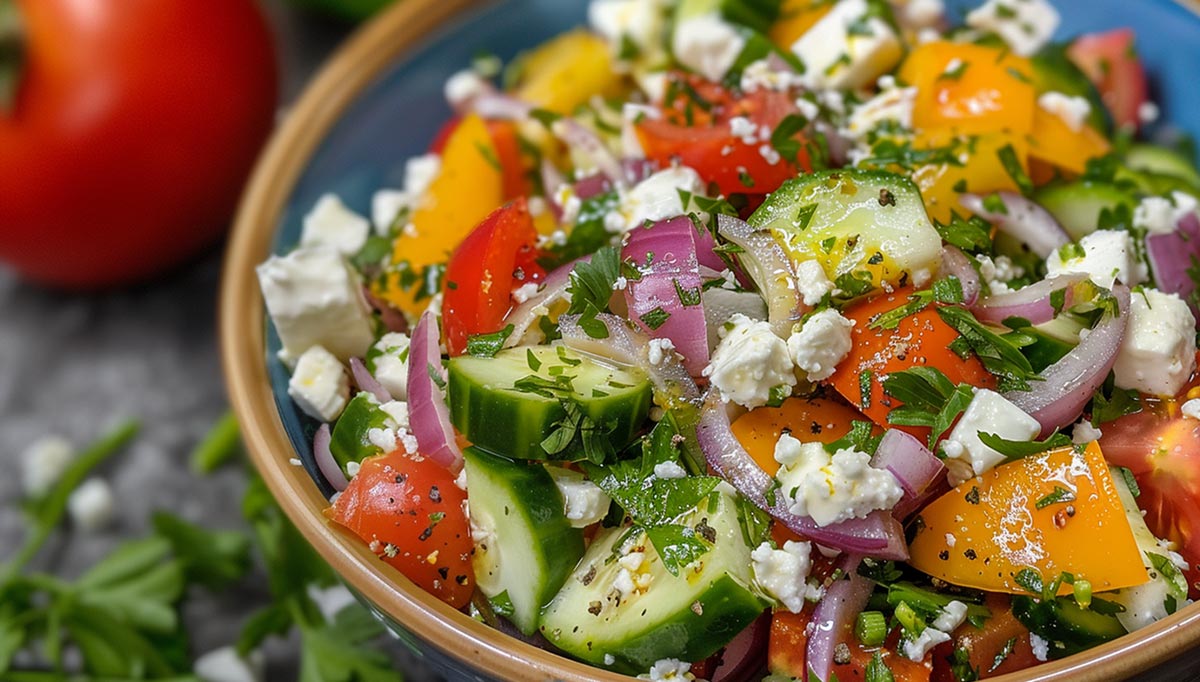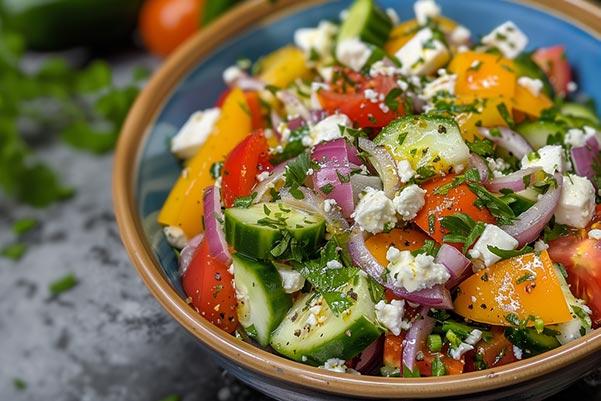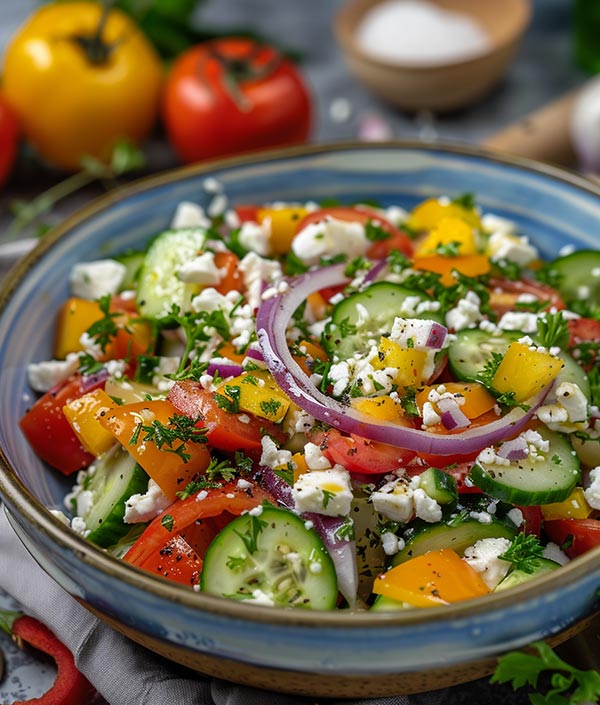Originating from the sun-kissed lands of Bulgaria, Shopska Salad is a true celebration of freshness and simplicity. Its vibrant medley of flavors and textures captures the essence of summer, making it a beloved staple on tables across the Balkans. With just a handful of ingredients, this Bulgarian salad effortlessly transforms into a harmonious symphony of colors and tastes, leaving your taste buds craving for more.
Every delightful bite of Shopska salad unveils a culinary gem that encapsulates the essence of summer. The crisp cucumbers, juicy tomatoes, and tangy feta cheese dance together in perfect harmony, while a drizzle of olive oil adds a touch of Mediterranean magic. But it's not just about appearances – the Shopska Salad delivers a delightful array of flavors with each mouthful, and it pairs perfectly with a big feast of grilled meat.
Fortunately, the Shopska salad is surprisingly simple to make. With just a handful of fresh ingredients, a dash of creativity, and a pinch of love, you can bring the magic of the Balkans to your own kitchen.

Shopska Salad Recipe
Prep Time
10 minutes
Cook Time
0 minutes
Rest Time
0 minutes
Total Time
10 minutes
Ingredients
Dressing And Garnishes
Directions
1. Begin by cleansing and prepping the vegetables, ensuring they are fresh and vibrant. Carefully dice the tomatoes, cucumber, bell pepper, and red onion into bite-sized pieces, ready to be incorporated into the salad. You can adjust the quantities of the vegetables according to your preference.
2. In a generous salad bowl, combine the chopped tomatoes, cucumber, bell pepper, and red onion. Gently toss the ingredients to ensure a harmonious blend of flavors and textures.
3. Delicately sprinkle the crumbled feta cheese over the vegetable medley, ensuring its even distribution. This will allow each bite of the salad to be graced with the cheese's creamy and salty goodness.
4. Season the salad with a pinch of salt and a grind of fresh black pepper, tailoring the flavors to your personal preference. Be mindful that the feta cheese adds some saltiness to the dish, so adjust the seasoning accordingly.
5. Drizzle the salad with a generous amount of extra-virgin olive oil. The oil enhances the flavors and helps bind the ingredients together.
6. Gently toss the salad, ensuring all the ingredients are lovingly coated with the dressing, allowing the flavors to meld together perfectly.
7. Garnish the Shopska salad with fresh parsley leaves, which will add a vibrant green touch and additional flavor.
8. Serve the salad promptly for immediate enjoyment or, if desired, refrigerate it briefly to allow the flavors to harmonize and mingle.
9. When ready to serve, transfer the salad to individual plates or a large serving dish, and let the vibrant colors of the vegetables shine.
Notes/ Tips
Dress Just Before Serving: To maintain the crispness of the vegetables, dress the salad with olive oil just before serving. This ensures that the salad stays fresh and vibrant.
Proper Vegetable Prep: Dice the tomatoes, cucumbers, bell peppers, and red onions into bite-sized pieces for consistent and enjoyable bites. Try to keep the vegetable pieces relatively uniform in size for a visually appealing presentation.
Swap Your Oil: Traditional Shopska salad is made with sunflower seed oil. For health or taste reasons, feel free to swap for extra virgin olive oil or another oil.
Nutritional Facts
Nutrition Facts
Servings: 2
Calories
201
% Daily Value*
Total Fat "7.1g"
"9%"
Saturated Fat "1g"
"5%"
Cholesterol "0mg"
"0%"
Sodium "233mg"
"10%"
Total Carbohydrate "34.2g"
"12%"
Dietary Fiber "4.2g"
"15%"
Total Sugars "20.1g"
"0%"
Protein "1.9g"
"0%"
Vitamin D "0mcg"
"0%"
Calcium "46mg"
"4%"
Iron "3mg"
"14%"
Potassium "604mg"
"13%"
*The % Daily Value (DV) tells you how much a nutrient in a food serving contributes to a daily diet. 2,000 calorie a day is used for general nutrition advice.
What Is A Shopska Salad
A Shopska salad is a traditional Bulgarian salad dish that has become a beloved staple in Bulgaria and across the Balkans. It is a refreshing and colorful salad known for its simplicity and vibrant flavors that showcase abundant fresh vegetables and dairy products. The salad comes from the Shopi people, an ethnic group inhabiting the Sofia region of Bulgaria.
The key ingredients of a Shopska salad are fresh and readily available, making it a popular choice during the summer months when ripe vegetables are abundant. The salad typically consists of diced tomatoes, cucumbers, onions, and bell peppers, arranged in a visually appealing manner. It is very similar to Greek salad but not a Greek salad. The vegetables are often topped with crumbled feta cheese and sprinkled with parsley, giving the salad a burst of flavor and an irresistible finishing touch.
As a side dish, Shopska salad is a fantastic complement to a ray of delicious meals, especially meat dishes. It's refreshing flavor truly shines when paired with succulent steaks, juicy grilled chicken, or delectable pork roasts.
The Shopska Salad Dressing
Shopska salad traditionally features a simple and light dressing that enhances the ingredients' natural flavors without overpowering them. The dressing typically consists of high-quality extra-virgin olive oil, which adds a smooth and fruity richness to the salad.

What Ingredients Will You Need To Make Shopska Salad
Ripe Tomatoes
The best variety of tomatoes to use for making a Shopska salad is one that is ripe, flavorful, and firm. While personal preference may vary, popular recommendations for this salad are Roma or Heirloom tomatoes for the best taste.
Roma tomatoes are medium-sized, oblong-shaped tomatoes with a rich, sweet flavor and dense flesh. Their meatiness makes them a popular choice for salads like Shopska salad.
Heirloom tomatoes, with their diverse range of shapes, sizes, and vibrant colors, are renowned for their exceptional flavor that delights the taste buds with every bite. They offer a unique and vibrant flavor profile, making them a fantastic choice to add a touch of novelty to your Shopska salad.
Cucumber
Look for fresh and crisp cucumbers. English, Kirby, or Persian cucumbers work well for this salad.
English cucumbers are also known as hothouse or seedless cucumber, and it is a popular choice for salads. It has a thin skin, mild flavor, and minimal seeds, and the flesh is tender and crisp, making it ideal for slicing and adding to the Shopska salad.
Similar to English cucumbers, Persian cucumbers are small, thin-skinned, and have a crunchy texture. Compared to other cucumber varieties, they tend to possess a sweeter and more delicate flavor profile, providing a delightful and subtle taste experience. Persian cucumbers work well in the Shopska salad, adding a refreshing crunch without overpowering the other ingredients.
Kirby cucumbers, also known as pickling cucumbers, are smaller in size, have slightly bumpy skin, and have a crisp texture and a refreshing taste. While they are commonly used for pickling, Kirby cucumbers can also be sliced and added to salads, including the Shopska salad.
Red Or Green Bell Peppers
Select a bell pepper of your choice to add vibrant color and mild sweetness to the salad.
Red Onion
Use a small red onion, which gives the salad a mild yet slightly pungent flavor.
Bulgarian Feta Cheese
Crumbled Bulgarian feta cheese is a crucial component of the Shopska salad. It adds a creamy and salty element that complements the vegetables. When selecting feta cheese for your Shopska salad, choose high-quality feta that is fresh and authentic. The brine-packed variety tends to be more flavorful, but if you prefer a milder taste, you can opt for a block of feta cheese and crumble it yourself.
If you prefer a milder taste, you can opt for less salty feta cheese or even substitute it with a similar crumbly cheese, such as goat cheese, sirene cheese (white brine cheese), or queso fresco. These cheeses provide a similar texture and can still deliver a creamy, tangy note to the salad. You can also use Greek feta, adding a more salty taste to the salad.
Fresh Parsley
Sprinkle fresh parsley leaves over the salad for a pop of vibrant green color and a hint of herbal freshness.
Sunflower Oil
Traditional Shopska salad is dressed with sunflower seed oil as the olive tree is not as plentiful in Bulgaria as in other Mediterranean regions. However, you can swap this ingredient with extra virgin olive oil, and it will still bring the flavors together while adding a silky richness.
Season the salad to taste with salt and pepper, enhancing the flavors of the vegetables and cheese.

How To Elevate Shopska Salad
If you want to elevate your Shopska salad and add some extra flair to the dish, here are a few ideas:
Add Fresh Herbs
Add chopped mint or basil leaves to the dish for a refreshing and aromatic twist. Just before serving, generously sprinkle them over the salad, infusing it with a burst of herbaceous goodness that will awaken your senses.
Roasted Red Peppers
For a touch of smokiness and complexity, include roasted red peppers in your Shopska salad. You can either roast them yourself or use store-bought roasted red peppers. Cut them into strips or dice them and mix them with the other vegetables for added flavor and color.
Toasted Nuts Or Seeds
Add texture and nutty flavors to your salad by including toasted nuts or seeds. Toasted pine nuts, slivered almonds, or pumpkin seeds can bring a delightful crunch and a nutty depth to the dish. Sprinkle them over the salad as a garnish.
Drizzle Balsamic Glaze
To add a touch of sweetness and tang, drizzle a balsamic glaze over your Shopska salad. The rich and syrupy glaze complements the fresh vegetables and feta cheese beautifully, enhancing the overall taste experience.
Grilled Vegetables
Grilling vegetables before adding them to the salad can take it to the next level. Grilled tomatoes, bell peppers, or even grilled zucchini can make the salad smoky and caramelized, creating a delightful contrast with the raw vegetables.
